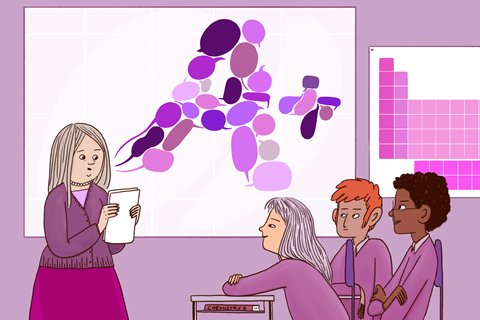Ditch marks and grades by using these time-saving methods
Feedback is often given in the form of marks or grades. This is a relatively quick process for us as teachers and neatly sums up a student’s attainment (particularly when compared to the number of marks available or to other students). However it’s not without its disadvantages:
- Students aren’t given any guidance on how their work can be improved;
- Students often compare themselves against their peers rather than focusing on the work;
- Marks or grades can demotivate lower attainers and cause high attainers to become complacent.
Providing comments, particularly as a replacement for grades rather than alongside them, solves these problems but there are concerns over the time involved. Here are some techniques that drive learning forward but don’t demand a lot of time.

Standardised criteria
Where a task or piece of work follows a common format, graph drawing for example, I standardise the success criteria. Rather than giving students a mark to show how many criteria have been met, direct students towards missing criteria or instruct them how to make improvements. To speed up this process even further, I print the criteria as a checklist and stick it on their graphs; download an example below.
This can be used flexibly; you can mark the checklist, students can do it for themselves or you can ask them to mark the list and then improve their graph accordingly.
7 simple rules to boost science teaching
Click to expand and explore the rules
Build on the ideas that pupils bring to lessons
Help pupils direct their own learning
Use models to support understanding
Support pupils to retain and retrieve knowledge
- Pay attention to cognitive load—structure tasks to limit the amount of new information pupils need to process
- Revisit knowledge after a gap to help pupils retain it in their long-term memory
- Provide opportunities for pupils to retrieve the knowledge that they have previously learnt
- Encourage pupils to elaborate on what they have learnt
Use practical work purposefully and as part of a learning sequence
Develop scientific vocabulary and support pupils to read and write about science
Use structured feedback to move on pupils’ thinking
Whole class feedback
The principle behind this isn’t new but applying it more systematically might be. While students are working, or after a lesson when looking through their books, I identify common misconceptions or mistakes, and feed them back to the whole class in an appropriate method, maybe on the board. Giving all the feedback to the whole class has the advantage that students are reassured they may have the same misunderstandings as many of their peers. There is also the obvious time-saving of not having to write out the same feedback in multiple students’ books.
Some may be concerned there isn’t any evidence of feedback in the students’ books. Although I don’t subscribe to the need for evidence for evidence’s sake, there is some advantage to having a record of feedback in students’ books for them to refer back to. You could address this with whole class feedback templates printed and stuck in their students’ books. There’s an excellent example and walkthrough on Mrthorntonteach.
Download an example of Standardised criteria as MS Word or pdf and an example of Coding feedback as MS Excel.
Coding feedback
Where feedback should be more personalised, for example following a topic test or on an extended piece of writing, I use a similar process. I go through the work listing common mistakes or errors and then determine what feedback I’d like to give the students. This might be pointing out misconceptions or giving instructions for students to improve the work. Rather than writing these comments on each piece of student work, try coding the feedback. Assign a code, or colour, to each comment and then only write that on the student work. You can present the full comments on the board or give students the full list to stick in their books or use in the lesson.
I have saved even more time using an Excel document shared with me by my school’s head of chemistry. Once you have written your list of feedback points, go through the student work again to select which pieces of feedback are relevant (Comment bank sheet in the example Excel downloadable below). You can print the second sheet (To be printed sheet) and cut it up for each student to stick in their book.
There is a temptation to use this alongside question level analysis (QLA) of test papers, but I’d avoid this as the feedback should be based on the specific mistakes students made rather than just the number of marks scored.
There are many advantages to giving students descriptive feedback as comments rather than grades, but there is certainly a time cost. Hopefully these methods might give you a first step at providing better feedback and a starting point for developing a method works best for you.
This article is part of the series 7 simple rules for science teaching, developed in response to the EEF’s Improving secondary science guidance. It supports rule 7c, Provide feedback as comments rather than marks.
Downloads
Standardised criteria example
Word, Size 50.09 kbStandardised criteria example
PDF, Size 42.02 kbCoding feedback example
Excel, Size 34.67 kb












1 Reader's comment